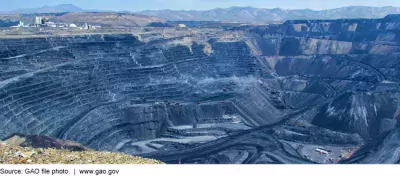Mining on Federal Lands After the Gold Rush
Neil Young once sang that he’d been a miner for a heart of gold. If he was on federal land, he may or may not have had to pay a royalty on any hardrock minerals he found, like copper, molybdenum, or, of course, gold. The related laws are a bit complex—but we’ve got Neil covered.
Today’s WatchBlog looks at our report on mining on federal lands.
A gold mine on federal lands in Nevada
Image

Rockin’ In the Free World
There are 2 types of federal lands: acquired lands and public domain lands.
- Acquired lands are those granted or sold to the United States by a state or citizen
- Public domain lands usually were never owned by a state or private citizen and make up about 90% of all federal lands
Different statutes and systems govern the management of solid minerals on each type of federal lands.
On acquired lands, hardrock mining is subject to federal laws that allow the federal government to maintain title to the land but establish terms for using it, including royalties to be paid to the federal government. This is called a leasing system. The Bureau of Land Management generally uses it to authorize mining on acquired federal lands.
On public domain lands, hardrock mining is generally subject to the General Mining Act of 1872, which allows people to locate minerals and stake a claim to obtain the exclusive right to extract them without paying a federal royalty. This is called a location system. The Bureau of Land Management and the Forest Service each maintain separate programs to evaluate and approve location system operations on lands they manage.
Besides hardrock mining, non-energy minerals (like sodium and phosphate) and coal can be mined on federal lands. This generally takes place under leasing systems. Operations under both location and leasing systems for both hardrock and non-energy minerals are subject to other environmental and natural resource management laws.
So, depending on the type of federal land and what kind of mineral is produced, mine operators may or may not be required to pay the government a royalty.
You Never Call
Our report dug deep into the data on mining on federal lands. We looked at hardrock, non-energy mineral, and coal mining there. We found that there are 872 authorized mining operations on about 1.3 million acres of federal land as of September 2018—most of which aren’t subject to royalties.
Mine operators paid about $550 million in royalties in FY 2018. But federal agencies don’t know exactly how productive hardrock mines on public domain lands are because these agencies generally don’t collect data from mine operators that don’t have to pay royalties.
To learn more about mining on federal lands, check out our report on the topic. To unearth still more on the topic, check out the data supplement.
- Comments on GAO’s WatchBlog? Contact blog@gao.gov.
GAO Contacts
Related Products

GAO's mission is to provide Congress with fact-based, nonpartisan information that can help improve federal government performance and ensure accountability for the benefit of the American people. GAO launched its WatchBlog in January, 2014, as part of its continuing effort to reach its audiences—Congress and the American people—where they are currently looking for information.
The blog format allows GAO to provide a little more context about its work than it can offer on its other social media platforms. Posts will tie GAO work to current events and the news; show how GAO’s work is affecting agencies or legislation; highlight reports, testimonies, and issue areas where GAO does work; and provide information about GAO itself, among other things.
Please send any feedback on GAO's WatchBlog to blog@gao.gov.




